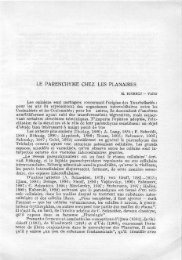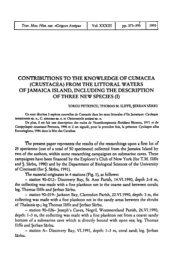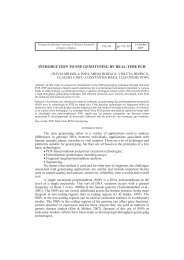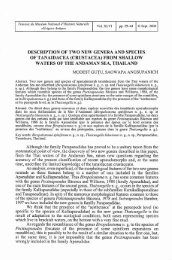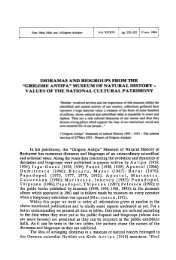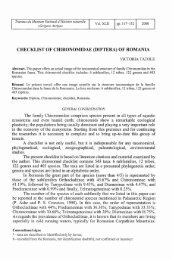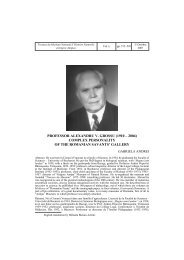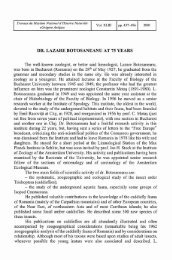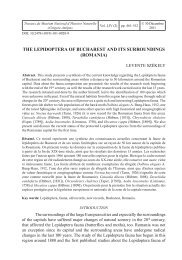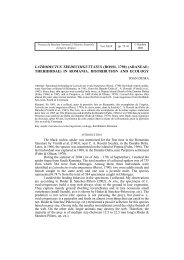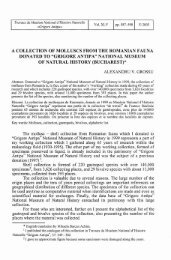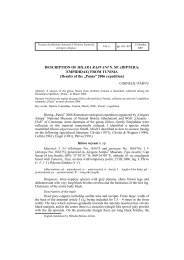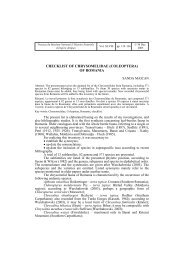cumacea (crustacea: peracarida) from western tropical ... - Travaux
cumacea (crustacea: peracarida) from western tropical ... - Travaux
cumacea (crustacea: peracarida) from western tropical ... - Travaux
Create successful ePaper yourself
Turn your PDF publications into a flip-book with our unique Google optimized e-Paper software.
<strong>Travaux</strong> du Muskum National d1Histoire Naturelle<br />
((Grigore Antipaw<br />
Vol. XLV<br />
pp. 117-128<br />
CUMACEA (CRUSTACEA: PERACARIDA) FROM WESTERN<br />
TROPICAL ATLANTIC*<br />
IORGU PETRESCU<br />
Abstract. A new species, Cumella thomasil~xei n.sp., is described, <strong>from</strong> Exuma Island (Bahamas) and<br />
other 20 species are identified: Cyclaspis goesi, Vaunthompsonia cf. cristata, Campylaspis heardi,<br />
C. paucispina, Cubanocuma gutzui, Cumella abacoensis, C. andri, C. biserrata, C. clavicauda,<br />
C. garrityi, C. gomoiui, C. longicaudata, C. cf. ocellata, C. ruetzleri, C. somersi, C. vicina, C. sp.,<br />
C. zimmeri, Elassocumella micruropus and Schizotrema sp. The first mentions on the <strong>cumacea</strong>ns of<br />
Exuma Islands (Bahamas), Grand Cayman and Honduras and completions of the fauna of Andros<br />
Island (Bahamas) are presented.<br />
Resume. On d6crit une nouvelle esptce, Cumella thomasil~rei n. sp., d'he Exhuma (Bahamas) et ont<br />
ete identifikes d'autres 20 esptces: Cyclaspis goesi, Vaunthompsonia cf. cristata, Campylaspis heardi,<br />
C. paucispina, Cubanocuma gutzui, Cumella abacoensis, C. andri, C. biserrata, C. clavicauda,<br />
C. garrityi, C. gomoiui, C. longicaudata, C. cf. ocellata, C. ruetzleri, C. somersi, C. vicina, C. sp.,<br />
C. zimmeri,~Elassocumella micruropus et Schizotrema sp. On prksente la premiere mention des<br />
cumacCs d' Ile Exhuma (Bahamas), Grand Cayman et Honduras et des mentions nouvelles pour la<br />
faune d'lle Andros (Bahamas).<br />
Key words: Cumacea, Bodotriidae, Namastacidae, new species, first records, <strong>western</strong> <strong>tropical</strong><br />
Atlantic.<br />
INTRODUCTION<br />
0 2003<br />
The <strong>cumacea</strong>n fauna of the Western Tropical Atlantic Ocean, <strong>from</strong> the<br />
shallow waters, was previously known <strong>from</strong> Bermuda (Bgcescu & Iliffe, 1991,<br />
Bgcescu, 1992, Petrescu, 1990, Petrescu & Sterrer, 2001), Bahamas (Petrescu &<br />
Iliffe, 1992, Petrescu, 1996), Jamaica (Petrescu, Iliffe & Sarbu, 1993, 1994), St.<br />
Martin (Sars, 187 1, 1873), Martinica (Zimmer, 1944), St. John-U.S. Virgin Islands<br />
(Calman, 1907, 191 I), Cuba (Zimmer, 1944, Bgcescu, 197 1, Bgcescu & Muradian,<br />
1977 a, b, Muradian-Ciamician, 1980, Ortiz & Lalana, 1988), Dutch Antilles -<br />
Bonaire and Curaqao (Bgcescu & Muradian, 1977 b); <strong>from</strong> continental coasts:<br />
Florida (Zimmer, 1943, 1944, Bgcescu, 1971, Bgcescu & Muradian, 1977 b,<br />
Watling, 1977, Radha Devi & Kurian, 1981), U.S. coasts of Gulf of Mexico<br />
(Zimmer, 1944, Jones & Burbanck, 1959, Bgcescu, 1971, Bicescu & Muradian,<br />
1977 a, b, Watling, 1977, Omholt & Heard, 1979, 1982, Muradian-Ciamician,<br />
1980, Radha Devi & Kurian, 1981, Roccatagliata & Heard, 1995), Mexico<br />
(Bgcescu, 197 1, Donath-Hernandez, 1988, 1992), Belize (Petrescu, 2002) and Costa<br />
Rica (Petrescu & Heard, 2003, Petrescu, Heard, Vargas & Breedy, 2003).<br />
The present paper fills some empty spaces in the knowledge of the <strong>cumacea</strong>n<br />
diversity <strong>from</strong> the west Atlantic <strong>tropical</strong> region by the study of the collected<br />
specimens <strong>from</strong> other islands than those already known, <strong>from</strong> Cayman Islands and<br />
<strong>from</strong> the coasts of Honduras. There are still large unresearched areas, both <strong>from</strong> the<br />
continental coast and <strong>from</strong> the insular one.<br />
* English translation by Mihaela Barcan Achim.
118 IORGU PETRESCU<br />
MATERIAL AND METHODS<br />
The material was collected <strong>from</strong> submarine caves and <strong>from</strong> the open sea by<br />
Dr. Thomas M. Iliffe <strong>from</strong> Bahamas (Andros Isl., Exuma Isl.) and Honduras and by<br />
Dr. Richard W. Heard <strong>from</strong> Grand Cayman Islands (Tab. 1). All specimens are<br />
preserved in the <strong>crustacea</strong>n collection of "Grigore Antipa" National Museum of<br />
Natural History (MGAB) <strong>from</strong> Bucharest.<br />
No<br />
1<br />
2<br />
3<br />
4<br />
5<br />
6<br />
7<br />
8<br />
9<br />
10<br />
I I<br />
12<br />
13<br />
14<br />
Locality<br />
North Andros Isl.,<br />
Conch Sound Blue Hole<br />
South Andros lsl., Four<br />
Sharks Blue Hole<br />
South Andros lsl., Four<br />
Shark Blue Hole<br />
South Andros Isl., Atlantis<br />
Blue Hole<br />
South Andros lsl., South<br />
Bight #2 Blue Hole<br />
South Andros Isl., South<br />
Bight #2 Blue Hole<br />
South Andros Island,<br />
Exley's Boiling Hole<br />
South Andros Island,<br />
Double Drop Blue Hole<br />
South Andros Isl., Vortex<br />
Hole, Middle Bight<br />
South Andros Island,<br />
Exley's Boiling Hole<br />
North Andros Island,<br />
Conch Sound Blue Hole<br />
South Andros Island,<br />
Four Shark Cave<br />
South Andros Island,<br />
Double Drop Cave<br />
Exumas, Wall at Transect<br />
AA Buoy (open ocean),<br />
Lee Stocking Island<br />
Station<br />
Collecting stations<br />
96-040<br />
97-023<br />
99-050<br />
99-051<br />
99-052<br />
99-053<br />
99-054<br />
99-055<br />
99-059<br />
99-060<br />
00-025<br />
00-027<br />
00-029<br />
94-01 8<br />
Data<br />
6.4.1996<br />
17.8.1 997<br />
1.10.1999<br />
2.10.1999<br />
3.10.1999<br />
4.10.1999<br />
5.10.1999<br />
6.10.1999<br />
13.10.1999<br />
14.10.1999<br />
17.8.2000<br />
20.8.2000<br />
21.8.2000<br />
19.5.1994<br />
Depth (m)<br />
26<br />
27-33<br />
60-70<br />
60-70<br />
53<br />
40<br />
60-70<br />
60-70<br />
40-45<br />
60-70<br />
25<br />
60<br />
50<br />
67<br />
Collecting conditions<br />
Table 1<br />
PN at 750 m penetration<br />
into cave<br />
PN <strong>from</strong> water column and<br />
silt on ledges at back of<br />
cavern zone<br />
PN <strong>from</strong> water column in<br />
past restriction<br />
PN <strong>from</strong> water column in<br />
past restriction<br />
SB <strong>from</strong> water column<br />
PN and suction bottle <strong>from</strong><br />
surface of silty sediments<br />
PN and SB <strong>from</strong> water<br />
column and surface of silty<br />
sediment<br />
PN <strong>from</strong> water column<br />
below thermocline<br />
PN <strong>from</strong> water column in<br />
past restriction<br />
PN <strong>from</strong> water column<br />
PN <strong>from</strong> sediment at about<br />
365 m inside cave<br />
PN <strong>from</strong> surface sediment<br />
about 100 m inside cave<br />
PN <strong>from</strong> water column at<br />
about 100-200 m inside<br />
cave<br />
PN <strong>from</strong> surface of silty<br />
sediments on ledges
15<br />
16<br />
17<br />
18<br />
19<br />
20<br />
21<br />
22<br />
23<br />
24<br />
25<br />
26<br />
27<br />
28<br />
29<br />
Exuma Cays, Wall<br />
(Transect AB Buoy),<br />
Lee Stocking Island<br />
Exuma Cays, Wall off<br />
Lee Stocking Island,<br />
Transect BA<br />
Exuma Cays, Norman's<br />
Pond Cave, Norman's<br />
Pond Cay<br />
Exumas, Angelfish<br />
Cave, Stocking Island<br />
Great Exuma, Crab<br />
Cay Crevasse, Crab<br />
Cay, Georgetown<br />
Great Exuma, Crab<br />
Cay Crevasse, Crab<br />
Cay, Georgetown<br />
PN -plankton net; SB- suction pump.<br />
NEW CUMACEA (CRUSTACEA) FROM WESTERN ATLANTIC 119<br />
Exuma Cays, Norman's<br />
Pond Cave, Norman's Pond<br />
Cay<br />
Exuma Cays, Master<br />
Harbour Cave, Great<br />
Exuma Island<br />
Great Exuma, Bottomly's<br />
Blue Hole, Stocking Isl.<br />
Great Exuma, The Subway<br />
Great Exuma, Mystery<br />
Cave, Stocking Island,<br />
Georgetown<br />
Great Exuma, Crab Cay<br />
Crevasse, Crab Cay,<br />
Georgetown<br />
Honduras, Stephen's Reef,<br />
Guanaja<br />
Honduras, Bayman Drop<br />
and Wonderful Reef, reef<br />
caves, Guanaja<br />
Grand Cayman Island<br />
94-020<br />
95-002<br />
95-003<br />
95-008<br />
95-009<br />
95-010<br />
95-01 1<br />
96-03 1<br />
99-065<br />
00-006<br />
00-019<br />
00-020<br />
95-025<br />
95-026<br />
4 A<br />
-<br />
22.5.1994<br />
12.5.1995<br />
14.5.1995<br />
18.5.1995<br />
18.5.1995<br />
18.5.1995<br />
16.5.1995<br />
9.9.1996<br />
27.3.1999<br />
22.3.2000<br />
8.8.2000<br />
9.8.2000<br />
3.12.1995<br />
4.12.1995<br />
13.8.1999<br />
62<br />
142<br />
3<br />
10<br />
6<br />
35<br />
4<br />
12 -1 5<br />
27-29<br />
60<br />
52<br />
41<br />
2 1<br />
10-15<br />
1-1.5<br />
PN <strong>from</strong> surface of sandy<br />
sediments on ledges of<br />
upper slope<br />
Grab sampler of Nekton<br />
Gamma submersible <strong>from</strong><br />
sandy sediment on ledge<br />
beneath rock outcropping<br />
SB <strong>from</strong> rocks in the<br />
cavern entrance<br />
SB <strong>from</strong> ledge at entrance<br />
of strongly tidal blue hole<br />
SB <strong>from</strong> algae covered<br />
rocks outside cave entrance<br />
PN <strong>from</strong> coarse sand and<br />
shell bottom about 100 m<br />
inside the strongly tidal<br />
blue hole<br />
SB <strong>from</strong> rocks just inside<br />
the cave entrance<br />
PN <strong>from</strong> the ceiling of this<br />
tidal blue hole cave<br />
PN and SB in crossover<br />
passages and Mystery<br />
Cave<br />
PN and SB <strong>from</strong> surface of<br />
silty sediments<br />
PN <strong>from</strong> surface of coarse<br />
sand about 150 m inside<br />
PN <strong>from</strong> surface of coarse<br />
sand on bottom about<br />
200 m inside<br />
PN <strong>from</strong> coarse sand on<br />
reef face<br />
PN <strong>from</strong> water column and<br />
rock walls of reef caves<br />
washings of carbonate<br />
rocks covered with algae,<br />
sponges, hydroids,<br />
anthozoans and tunicates
120 lORGU PETRESCU<br />
RESULTS<br />
Twenty-one species, belonging to seven genera and two families, were<br />
identified, one of them new to science.<br />
Family Bodotriidae<br />
Cyclaspis goesi (Sars, 187 1 )<br />
Material. 1 9, sta. 94-01 8, 19.5.1994; 1 immat. d, sta. 94-020, 22.5.1994,<br />
Exuma Island.<br />
Remarks<br />
First record <strong>from</strong> Bahamas; the species was mentioned <strong>from</strong> St. Martin Island<br />
by Sars (1 871, 1873) and <strong>from</strong> Belize by Petrescu (2002).<br />
Grand Baharna<br />
Crooked lsl.<br />
Fig. 1 - Map of Bahamas with collecting places.<br />
Vaunthompsonia cf. cristata Bate, 1858<br />
0<br />
Caicos Islands<br />
Material. Exuma Island - 3 99, sta. 95-003, 14.5.1995; 2 immat. dc?, 1 d,<br />
sta. 95-009, 18.5.1995; 2 99, sta. 95-010, 18.5.1995; 2 99, 2 dc?, sta. 95-01 1,<br />
16.5.1995; 2 99, 1 immat. d,1 juv, sta. 94-020, 22.5.1994; Honduras- 1 Q, sta.95-<br />
25; 4 99, sta. 95-026.
NEW CUMACEA (CRUSTACEA) FROM WESTERN ATLANTIC 121<br />
Remarks<br />
Anteriorly mentioned only <strong>from</strong> Florida, U.S. Virgin Islands, Belize and<br />
Costa Rica (Petrescu, Heard, Vargas and Breedy, 2003).<br />
Family Nannastacidae<br />
Campylaspis heardi Muradian-Ciamician, 1980<br />
Material. Andros Island - 1 d , sta. 99-053; Exuma Island - 1 9, sta. 95-002,<br />
12.5.1995; Honduras - 2 99, 1 juv, sta. 95-026.<br />
Remarks<br />
Previous distribution: Gulf of Mexico, Cuba (Muradian-Ciamician, 1980),<br />
Jamaica (Petrescu, Iliffe & Sarbu, 1994), Belize (Petrescu, 2002).<br />
Campylaspis paucispina Jones, 1974<br />
Material. Andros Island - 2 rnanca, sta. 99-053; Bahamas - 6 99, 6 d'd,<br />
3 rnanca, sta. 97-023, 17.8.1997.<br />
Remarks<br />
Similar morphology with specimens known <strong>from</strong> Gay Head, Florida (Jones,<br />
1974).<br />
Cubanocuma gutzui Bgcescu & Muradian, 1977<br />
Material. Andros Island - 1 9, sta. 00-027, Four Shark Cave, 20.8.2000;<br />
Exuma Island - 1 d , sta. 95-0 10, 18.5.1995; 1 9, sta. 94-020,22.5.1994; Honduras -<br />
2 99, sta. 95-025.<br />
Remarks<br />
This species is largely distributed in the <strong>western</strong> Atlantic: Florida, Gulf of<br />
Mexico, Cuba (Bgcescu & Muradian, 1977 a), Jamaica (Petrescu, Iliffe & Sarbu,<br />
1994), Abaco (Petrescu, 1996); Petrescu and Sterrer (2001) found little different<br />
specimens in Bermuda (attributed to C. cf. gutzui).<br />
Cumella abacoensis Petrescu, 1996<br />
Material. Andros Island - 49 99, sta. 00-025, Conch Sound Blue Hole,<br />
17.8.2000; 2 juv, sta. 00-027, Four Shark Cave, 20.8.2000; 2 99, 1 immat. d , sta.<br />
00-029, Triple Traverse Cave, 21.8.2000; 1 9, 1 d', sta. 99-050; 5 99, sta. 99-05 1 ;<br />
2 d d, sta. 99-052; 202 99,106c?d, 35 rnanca, 44 juv, sta. 99-053; 1699,17 dd',<br />
4 juv, sta. 99-054; 1 9,2 dd, sta. 99-055; 3 99,4 66, sta. 99-059; 3 99, 5 d'd',<br />
sta. 99-060; 7 99, 1 8 , sta. 99-065; Exuma Island - 8 99, sta.95-008, 18.5.1995;<br />
6 99, sta. 00-019, Mistery Cave, Stocking Isl., Georgetown, Great Exuma; 2 99,<br />
1 immat. d', sta. 00-020, Crab Cay Crevasse, Georgetown, Great Exuma, 9.8.2000;<br />
20 99,4 c?d, 7 juv, sta. 00-006, The Subway, Great Exuma, 22.3.2000; 3 99, sta.<br />
96-031, 9.9.1996; 3 juv, sta. 96-034, 14.9.1996; 11 99, 3 d'd', 1 juv, sta. 96-040,<br />
6.4.1996; 1 9, sta. 96-091, 8.5.1996; Bahamas Islands - 55 90, 24 d'd, 2 rnanca,<br />
sta. 97-023, 17.8.1997; Grand Cayman - 6 99, 1 d .
122 IORGU PETRESCU<br />
Remarks<br />
Most abundant species of Cumella <strong>from</strong> material of Bahamas, anteriorly<br />
mentioned only <strong>from</strong> the terra tipica, Abaco Island (Petrescu, 1996).<br />
Cumella andri Petrescu & Iliffe, 1992<br />
Material. 4 99, sta. 94-020, 22.5.1994; 3 99, 2 d d, sta. 00-019, Mistery<br />
Cave, Stocking Isl., Georgetown, Great Exuma; 2 99, sta. 96-020,8.9.1996; 3 O9,3<br />
dd, sta. 96-040,6.4.1996, Exuma Islands.<br />
Remarks<br />
First time mentioned <strong>from</strong> Andros Island (Petrescu & Iliffe, 1992).<br />
Cumella biserrata Petrescu, 2002<br />
Material. 1 manca, 1 d , sta. 95-025; 1 9, 1 juv, sta. 95-026, Honduras.<br />
Remarks<br />
Also known <strong>from</strong> Belize (Petrescu, 2002) and Costa Rica (Petrescu, Heard,<br />
Vargas & Breedy, 2003).<br />
Cumella clavicauda Calman, 1 9 1 1<br />
Material. Andros Island - 4 d d, sta. 99-059; Honduras - 1 juv, sta. 95-025.<br />
Remarks<br />
This species has one of the largest known distribution in the <strong>western</strong> Atlantic:<br />
St. John, U.S. Virgin Islands (Calman, 191 l), Florida, Cuba, Curaqao, Gulf of<br />
Mexico (Biicescu & Muradian, 1977 b) and Belize (Petrescu, 2002).<br />
Cumella garrityi BBcescu & Muradian, 1977<br />
Material. Exuma Islands - 1 d, sta. 95-009, 18.5.1995; Honduras - 1 juv, sta.<br />
95-025; 3 99,2 gd, sta.95-026.<br />
Remarks<br />
Another largely distributed species, <strong>from</strong> Florida, Gulf of Mexico (BBcescu &<br />
Muradian, 1977 b), Belize (Petrescu, 2002), Abaco Island (Bahamas) (Petrescu,<br />
1996) and Costa Rica (Petrescu, Heard, Vargas & Breedy, 2003).<br />
Cumella gomoiui BBcescu & Muradian, 1977<br />
Material. 1 d , sta. 95-01 1, 16.5.1995; 1 d, sta. 94-020, 22.5.1994, Exuma<br />
Islands.<br />
Remarks<br />
Anteriorly known <strong>from</strong> Cuba, Abaco, Belize and Costa Rica.<br />
Cumella longicaudata Petrescu, Iliffe & Sarbu, 1994<br />
Material. 1 9, sta. 94-01 8, 19.5.1994, Exuma Islands.
NEW CUMACEA (CRUSTACEA) FROM WESTERN ATLANTIC 123<br />
Remarks<br />
This species was known only <strong>from</strong> terra tipica, Jamaica (Petrescu, Iliffe &<br />
Sarbu, 1994). Our specimens have fewer dorsal spines on carapace than Jamaican<br />
ones (four instead of six).<br />
Cumella cf. ocellata Biicescu, 1992<br />
Material. Andros Island - 14 d d, sta. 99-059; Honduras - 2 d d, sta.95-025;<br />
Grand Cayman - 46 9 9, 1 7 d d .<br />
Remarks<br />
Similar to the specimens recorded <strong>from</strong> Bermuda (Biicescu, 1992, Petrescu &<br />
Sterrer, 2001), Belize and Costa Rica.<br />
Cumella ruetzleri Petrescu, 2002<br />
Material. 59 99,2 1 d d, Grand Cayman.<br />
Remarks<br />
Previously distribution: Belize and Costa Rica.<br />
Cumella somersi Petrescu & Sterrer, 2001<br />
Material. 40 99,2 dd, Grand Cayman.<br />
Remarks<br />
Described <strong>from</strong> Bermuda and found after that in Belize and Costa Rica.<br />
Cumella sp.<br />
Material. 2 juv, sta. 95-025, Honduras.<br />
Cumella thomasiliffei n.sp.<br />
(Fig. 2)<br />
Material. Holotype: female, no. CUM 1449; paratypes: 4 99, 1 3, sta. 94-<br />
020, 19.5.1994, no. CUM 1450; 2 99, sta. 94-01 8, 22.5.1994, 62 m, Exuma Cays,<br />
no. CUM 1451.<br />
Type locality. Bahamas, 62 m, Exuma Cays, Wall (Transect AB Buoy), Lee<br />
Stocking Island, sta. 94-020, collected on 22.05.1994, by Thomas M. Iliffe.<br />
Etymology. The species is dedicated in Dr. Thomas M. Iliffe's honour (A & M<br />
University, Galveston, Texas) as a sign of high gratitude for his generosity to put at<br />
our disposal lots and lots of <strong>cumacea</strong>ns <strong>from</strong> the Caribbean for study, along the time.<br />
Description of female<br />
Body (Fig. 2 A), elongate, with few hairs on carapace. Length: 5.4 mm.<br />
Carapace (Fig. 2 A, B), a little shorter than a third of entire body length, four<br />
spines on ocular lobe, short pseudorostrum, large antenna1 notch, serrated antero-<br />
ventral margin.<br />
Antenna I (Fig. 2 C), middle segment of peduncle a little shorter than the last<br />
one, with a small tubercle with sensory setae, thin and long main flagellum with two<br />
segments; accessory flagellum shorter than half of basal segment of main flagellum.
124 IORGU PETRESCU<br />
Maxilliped 3 (Fig. 2 D), basis, half of maxilliped, without outer process with<br />
two strong plumose setae; outer process of merus reaching the extremity of carpus;<br />
dactylus with a long and robust terminal seta.<br />
Pereopod 1 (Fig. 2 E), basis a third of entire pereopod, ischium as long as<br />
merus, carpus as long as propodus, twice longer than dactylus, dactylus with a long<br />
and robust terminal seta.<br />
Pereopod 2 (Fig. 2 F), basis a little shorter than half of pereopod, carpus 1.4<br />
times longer than merus, with two stout setae on inner distal corner, dactylus two<br />
times longer than propodus.<br />
Pereopods 3-5 (Fig. 2 G-I), with progressively shorter basis and longer<br />
carpus, dactylus fused with its robust terminal seta.<br />
Uropod (Fig. 2 J), peduncle a little more than twice times longer than last<br />
pleonite, 1.3 times longer than its endopod, with a strong serration on inner margin;<br />
endopod a little longer than exopod, with three robust setae on inner strong serrated<br />
margin, both rami with a long robust terminal seta.<br />
Remarks<br />
Most related species to Cumella thomasiliffei n.sp. is C. biserrata Petrescu<br />
(2002) described <strong>from</strong> Belize regarding carapace with dorsal serration on ocular<br />
lobe, its antero-ventral margin also serrated and almost similar uropods. It differs<br />
by: unique row of spines on ocular lobe instead double one, pseudorostral lobes<br />
with smooth margins versus serrated, longer uropodal peduncle (pedun~le16'~<br />
pleonite: 2.15 in C. thomasilzffei and 1.4 in C. biserrata), longer uropodal rami<br />
(pedunclelendopod: 1.36 in C. thomasilzffei and 1.59 in C. biserrata), uropodal<br />
endopod with three robust setae on inner margin versus two.<br />
Cumella vicina Zimmer, 1944<br />
Material. 2 dd', sta. 95-01 1, 16.5.1995, Exuma Islands.<br />
Remarks<br />
Formerly mentioned <strong>from</strong> Florida, Gulf of Mexico, Cuba, Jamaica and Belize.<br />
Cumella zimmeri Petrescu, Iliffe & Sarbu, 1994<br />
Material. 1 9, sta. 00-019, Mistery Cave, Stocking Isl., Georgetown, Great<br />
Exuma; 1 9, sta. 00-020, Crab Cay Crevasse, Georgetown, Great Exuma, 9.8.2000,<br />
Exuma Island.<br />
Remarks<br />
First mentioned <strong>from</strong> Bahamas, known only <strong>from</strong> Jamaica.<br />
Elassocumella micruropus (Zimmer, 1943)<br />
Material. 1 9, Grand Cayman.<br />
Remarks<br />
Recorded <strong>from</strong> Florida, Bonaire (Dutch Antilles) and Costa Rica.<br />
Schizotrema sp.<br />
Material. 1 manca, sta.95-025, Honduras.
NEW CUMACEA (CRUSTACEA) FROM WESTERN ATLANTIC 125<br />
Fig. 2 - Cumella thomasiliffei asp. Female: A, body, lateral view; B, carapace, dorsal view; C, antenna<br />
1; D, maxilliped 3; E, pereopod 1; F, pereopod 2; G, pereopod 3; H, pereopod 4; 1, pereopod 5;<br />
J, uropod. Scale bars (in mm): A, 0.5; B, 0.3; C, 0.1; D-I, 0.2; J, 0.2.
126 IORGU PETRESCU<br />
REMARKS ON THE CUMACEAN FAUNA FROM THE WESTERN<br />
TROPICAL ATLANTIC OCEAN<br />
After this study 21 species are mentioned <strong>from</strong> Bahamas, only 11 previously<br />
known <strong>from</strong> Andros Island and Abaco Island. Five species are mentioned <strong>from</strong> the<br />
Andros Island for the first time (six species previously known): Campylaspis<br />
paucispina, Cubanocuma gutzui, Cumella abacoensis, C. clavicauda and C. cf.<br />
ocellata. The first data on the <strong>cumacea</strong>n fauna <strong>from</strong> Exuma Island (also <strong>from</strong><br />
Bahamas archipelago) mention 12 species: Cyclaspis goesi, Vaunthompsonia cf.<br />
cristata, Campylaspis heardi, Cubanocuma gutzui, Cumella abacoensis, Cumella<br />
andri, Cumella garrityi, Cumella gomoiui, Cumella longicaudata, Cumella<br />
thomasiliffei n.sp., Cumella vicina and Cumella zimmeri. The species previously<br />
known <strong>from</strong> the coasts of Florida and Central America, of Cuba, some of them with<br />
a large distribution in the area (for instance Cumella clavicauda) and some of them<br />
com'mon only to those <strong>from</strong> the waters of Jamaica (Cumella longicaudata and C.<br />
zimmeri) were added to the researched area. As yet, the species occurred in Bermuda<br />
are absent (Cumella hirsuta, C. serrata, C. somersi, Schizotrema agglutinanta, S.<br />
wittmanni). Also, the described species <strong>from</strong> Bahamas are not mentioned <strong>from</strong><br />
Bermuda, the presence of a geographical barrier between these areas being possible.<br />
Within both cases, the population of these islands seems to be made by the active<br />
oceanic currents <strong>from</strong> the west to the east of the <strong>western</strong> <strong>tropical</strong> Atlantic region,<br />
towards the Gulf Stream.<br />
As regards the Grand Cayman Island, placed in the south of Cuba, between<br />
Jamaica and the coast of Central America, the first <strong>cumacea</strong>n species are mentioned:<br />
Cumella abacoensis, C. cf. ocellata, C. ruetzleri, C. somersi and Elassocumella<br />
micruropus. The small number of taxa can be explained mostly by the fact that only<br />
a single sample was studied, collected <strong>from</strong> shallow waters. The identified species<br />
are common to those <strong>from</strong> Bahamas (Cumella abacoensis), but also to those <strong>from</strong><br />
Bermuda (Cumella cf. ocellata, C. somersi), Belize and Costa Rica (C. cf. ocellata,<br />
C. ruetzleri, C. somersi, Elassocumella micruropus) and also to those <strong>from</strong> Florida<br />
and Lesser Antilles (Elassocumella micruropus).<br />
The <strong>cumacea</strong>ns <strong>from</strong> the Caribbean waters of Central America are known<br />
<strong>from</strong> the coasts of Mexico, Belize and of Costa Rica: The first data <strong>from</strong> Honduras<br />
show the presence of nine species, all of them, excepting the last two, found also<br />
previously in Belize: Vaunthompsonia cf. cristata, Campylaspis heardi, Cubano-<br />
cuma gutzui, Cumella biserrata, C. clavicauda, C. garrityi, C. cf. ocellata, Cumella<br />
sp. and Schizotrema sp. As in the case of the Grand Cayman Island, the results came<br />
<strong>from</strong> the study of a too small number of samples (two) for drawing a conclusion.<br />
ACKNOWLEDGEMENTS<br />
I want to thank to Dr. Thomas M. Iliffe (A&M University, Galveston, Texas) and to Dr.<br />
Richard W. Heard (College of Marine Sciences, University of Southern Mississippi) for their kindness<br />
for putting at my disposal the valuable material collected <strong>from</strong> the <strong>western</strong> <strong>tropical</strong> Atlantic; to Aurora<br />
Dinu ("Grigore Antipa" National Museum of Natural History, Bucharest), for tracing the drawings in<br />
China ink and to the anonymous referees for their contribution to the improving of the text.
NEW CUMACEA (CRUSTACEA) FROM WESTERN ATLANTIC 127<br />
CUMACEA (CRUSTACEA: PERACARIDA)<br />
DIN OCEANUL ATLANTIC DE VEST TROPICAL<br />
REZUMAT<br />
intr-un lot de cumacee provenind din Oceanul Atlantic de vest <strong>tropical</strong> - arhipelagul<br />
Bahamas (Insula Andros, lnsulele Exuma $i Insula Great Bahama), Insula Grand Cayman $i de la<br />
coastele Honduras-ului - am identificat 21 specii, din care una este noua pentru $tiinti: Cumella<br />
thomasiliflei n.sp. din Exuma. Aceast2 specie este mai apropiati de Cumella biserrata Petrescu, 2002<br />
din Belize. Alte specii determinate: Cyclaspis goesi (Sars), Vaunthompsonia cf. cristata Bate,<br />
Campylaspis heardi Muradian-Ciamician, C. paucispina Jones, Cubanocuma gufzui Bgcescu &<br />
Muradian, Cumella abacoensis Petrescu, C, andri Petrescu & Iliffe, C. biserrata Petrescu, C.<br />
clavicauda Calman, C. garrityi Bgcescu & Muradian, C. gomoiui Bgcescu & Muradian, C.<br />
Iongicaudata Petrescu, lliffe & Sarbu, C. cf. ocellata Bgcescu, C. ruefzleri Petrescu, C. somersi<br />
Petrescu & Sterrer, C, vicina Zimmer, Cumella sp., C. zimmeri Petrescu, Iliffe & Sarbu, Elassocumella<br />
micruropus (Zimmer) $i Schizotrema sp. De asemenea, sunt facute $i primele mentiuni ale cumaceelor<br />
din Ins. Exuma (Bahamas), Grand Cayman $i Honduras $i completari ale faunei din I. Andros<br />
(Bahamas).<br />
LITERATURE CITED<br />
BACESCU, M., 1971 -New Cumacea <strong>from</strong> the littoral waters of Florida (Caribbean Sea). <strong>Travaux</strong> du<br />
Museum d'Histoire Naturelle "Grigore Antipa", 11: 5-24.<br />
BACESCU, M., 1992 - Deux esptces nouvelles de Cumella (Crustacea, Cumacea) des grottes sous-<br />
marines de Bermuda. <strong>Travaux</strong> du Museum d'Histoire Naturelle "Grigore Antipa",<br />
32: 257-262.<br />
BACESCU, M., T. M. ILIFFE, 1991 - Nouvelles especes de Cumella des grottes sous-marines de<br />
Bermude. Revue Roumaine Biologie - Biologie Animale, 36 (1-2): 9-13.<br />
BACESCU, M., Z. MURADIAN, 1977 a - Cubanocuma gutzui gen. et sp. n. (Cumacea,<br />
Nannastacidae) <strong>from</strong> the <strong>tropical</strong> <strong>western</strong> Atlantic. Revue Roumaine de Biologie. SCrie<br />
Biologie Animale, 22: 3-9.<br />
BACESCU, M., Z. MURADIAN, 1977 b - Species of the genus Cumella (Cumacea, Nannastacidae)<br />
<strong>from</strong> the Western Tropical Atlantic. <strong>Travaux</strong> du Museum d'Histoire Naturelle "Grigore<br />
Antipa", 18: 89-102.<br />
CALMAN, W. T., 1907 - On new and rare Crustacea of the Order Cumacea <strong>from</strong> the collection of the<br />
Copenhagen Museum. Part I. The Families Bodotriidae, Vaunthompsoniidae and<br />
Leuconidae. Transactions Zoological Society London, 18 (I): 1-39.<br />
CALMAN, W. T., 191 1 - On new and rare Crustacea of the Order Cumacea <strong>from</strong> the collection of the<br />
Copenhagen Museum - Part 11. The Families Nannastacidae and Diastylidae.<br />
Transactions Zoological Society London, 18 (4): 383-385.<br />
DONATH-HERNANDEZ, F. E., 1988 - Cumacea form the Gulf of Mexico and the Caribbean Sea<br />
(Crustacea, Peracarida). I: Descriptions of known species, new records and range<br />
extensions. Caribbean Journal of Science, 24 (1-2): 44-5 I.<br />
DONATH-HERNANDEZ, F. E., 1992 - Cumella (Cumewingia) siankaana n. sp. <strong>from</strong> the Caribbean<br />
coast of Quintana Roo, Mexico (Cumacea Nannastacidae). In: Diversidad Biologics<br />
Reserva Biosfera Sian Ka' an Quintana Roo, Mexico, 2: 163-167.<br />
JONES, N. S., 1974 - Campylaspis species (Crustacea, Cumacea) <strong>from</strong> the deep Atlantic. Bulletin<br />
British Museum (Natural History) (Zoology), 27 (6): 247-300.<br />
JONES, N. S., W. D. BURBANCK, 1959 - Almyracuma proximoculi gen. et sp. nov. (Crustacea,<br />
Cumacea) <strong>from</strong> brackish water of Cape Cod, Massachusetts. Biological Bulletin, 116<br />
(I): 115-124.<br />
MURADIAN-CIAMICIAN, Z., 1980 - On some species belonging to the genus Campylaspis<br />
(Cumacea, Nannastacidae) <strong>from</strong> the collections of the Natural History Museum<br />
"Grigore Antipa". <strong>Travaux</strong> du Museum d'Histoire Naturelle "Grigore Antipa", 21:<br />
73-88.
128 IORGU PETRESCU<br />
OMHOLT, P. E., R. W. HEARD, 1979 - A new species of Spilocuma (Cumacea: Bodotriidae:<br />
Mancocuminae) <strong>from</strong> the Gulf of Mexico. Proceedings Biological Society<br />
Washington, 92 (1): 184- 194.<br />
OMHOLT, P. E., R. W. HEARD, 1982 - Cyclaspis bacescui, new species (Cumacea: Bodotriidae)<br />
<strong>from</strong> the eastern Gulf of Mexico. Journal Crustacean Biology, 2 (1): 120-129.<br />
ORTIZ, M., R. R. LALANA, 1988 - Lista de especies y bibliografia de 10s crusthceos de Cuba. 11.<br />
Cirripedia, Phyllocarida, Pancarida, Mysidacea, Tanaidacea y Cumacea. Revista de<br />
Investigaciones Marinas, 9 (2): 11-19.<br />
PETRESCU, I., 1990 - Campylaspis cousteaui, a new Cumacean species <strong>from</strong> the submarine caves of<br />
Bermuda. Revue Roumaine Biologie Strie Biologie Animale, 35 (1): 9-12.<br />
PETRESCU, I., 1996 - Cumaceans (Crustacea: Peracarida) <strong>from</strong> Abaco Island (Bahamas). <strong>Travaux</strong> du<br />
Musbum National d'Histoire Naturelle "Grigore Antipa", 36: 157-183.<br />
PETRESCU, I., 2002 - Cumacea (Crustacea: Peracarida) <strong>from</strong> Belize. <strong>Travaux</strong> du MusCum National<br />
d'Histoire Naturelle "Grigore Antipa", 44: 141-203.<br />
PETRESCU, I., R. W. HEARD, 2003 - Three new species of Cumacea (Crustacea, Peracarida) <strong>from</strong><br />
Costa Rica. Proceedings Biological Society Washington, (in press)<br />
PETRESCU, I., T. M. ILIFFE, 1992 - Contributions to the knowledge of the Cumacean species<br />
(Crustacea, Cumacea) of British Blue Holes (Andros Island, Bahamas Island). <strong>Travaux</strong><br />
du MusCum d'Histoire Naturelle "Grigore Antipa", 32: 283-302.<br />
PETRESCU, I., W. STERRER, 2001 - Cumacea (Crustacea) <strong>from</strong> shallow waters of Bermuda.<br />
Annalen der Naturhistorisches Museum Wien, 103B: 89-128.<br />
PETRESCU, I., T. M. ILIFFE, S. SARBU, 1993 - Contributions to the knowledge of Cumacea<br />
(Crustacea) <strong>from</strong> the littoral waters of Jamaica Island, including the description of three<br />
new species (I). <strong>Travaux</strong> du MusCum d'Histoire Naturelle "Grigore Antipa", 33:<br />
373-395.<br />
PETRESCU, I., T. M. ILIFFE, S. SARBU, 1994 - Contributions to the knowledge of the <strong>cumacea</strong>ns<br />
(Crustacea) <strong>from</strong> Jamaica 11. Five new species of the genus Cumella. <strong>Travaux</strong> du<br />
MusCum d'Histoire Naturelle "Grigore Antipa", 34: 347-367.<br />
PETRESCU, I., R. W. HEARD, R. VARGAS, 0. BREEDY, 2003 - Preliminary observations on the<br />
Cumacea (Crustacea: Peracarida) <strong>from</strong> the Caribbean and Pacific coasts of Costa Rica.<br />
In: Marine Biodiversity of Costa Rica, Central America. CortCs, J. & I.S. Wehrtmann<br />
(eds). Monographiae Biologicae. H. J. Dumont & M. J. A. Werger (eds), Kluwer<br />
Academic Publishers, The Netherlands. (in press)<br />
RADHA DEVI, A., C. V. KURIAN, 1981 -Three new species of Cumacea <strong>from</strong> the Gulf of Mexico.<br />
Bulletin Department Marine Sciences University Cochin, 12 (1): 53-64.<br />
ROCCATAGLIATA, D. C., R. W. HEARD, 1995 - Two species of Oxyurostylis (Crustacea:<br />
Cumacea: Diastylidae), 0. smithi Calman, 1912 and 0. lecroyae, a new species From<br />
the Gulf of Mexico. Proceedings Biological Society Washington, 108 (4): 596-612.<br />
SARS, G. O., 1871 - Beskrivelse af fire vestindiske Cumaceer opdgede af Dr. A. Goes. 0fv. Ak. Forh.,<br />
28: 803-81 1.<br />
SARS, G. O., 1873 - Beskrivelse af syv nye Cumaceer fra vestindien og det syd-Atlantiske Ocean.<br />
Kongl. Svenska Vetenskaps-Akademiens Handlingar, 1 1 (8): 1-30.<br />
ZIMMER, C., 1943 - iiber neue und weniger bekannte Cumaceen. Zoologischer Anzeiger, 141 (7-8):<br />
148-167.<br />
ZIMMER, C., 1944 - Cumaceen des tropischen Westatlantiks. Zoologischer Anzeiger, 144: 121 - 137.<br />
WATLING, L., 1977 - Two new genera and a new subfamily of Bodotriidae (Crustacea: Cumacea)<br />
From eastern North America. Proceedings Biological Society Washington, 89 (52):<br />
593-598.<br />
Received: January 9, 2003<br />
Accepted: Februay 28,2003<br />
Muzeul Nafional de Istorie Natural6 "Grigore Antipa"<br />
$os. Kiseleffnr.1. 011341 Bucurejti 2. Romcinia<br />
e-mail: iorgup@antipa.ro



